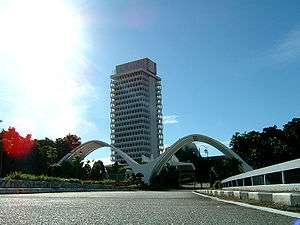Occupational Safety and Health Act 1994
| Occupational Safety and Health Act 1994 | |
|---|---|
 | |
| Parliament of Malaysia | |
| An Act to make further provisions for securing the safety, health and welfare of persons at work, for protecting others against risks to safety or health in connection with the activities of persons at work, to establish the National Council for Occupational Safety and Health, and for matters connected therewith. | |
| Citation | Act 514 |
| Territorial extent | Malaysia |
| Enacted by | Dewan Rakyat |
| Date passed | 20 October 1993 |
| Enacted by | Dewan Negara |
| Date passed | 16 December 1993 |
| Date of Royal Assent | 15 February 1994 |
| Date commenced | 24 February 1994 |
| Date effective | 25 February 1994 |
| Legislative history | |
| Bill introduced in the Dewan Rakyat | Occupational Safety and Health Bill 1993 |
| Introduced by | M. Mahalingam, Deputy Minister of Human Resources |
| First reading | 18 October 1993 |
| Second reading | 19 October 1993 |
| Third reading | 20 October 1993 |
| Bill introduced in the Dewan Negara | Occupational Safety and Health Bill 1993 |
| Introduced by | M. Mahalingam, Deputy Minister of Human Resources |
| First reading | 13 December 1993 |
| Second reading | 16 December 1993 |
| Third reading | 16 December 1993 |
| Related legislation | |
|
Merchant Shipping Ordinance 1952 [Ord. No. 70 of 1952] Merchant Shipping Ordinance 1960 of Sabah [Sabah Ord. No. 11 of 1960] Merchant Shipping Ordinance 1960 of Sarawak [Sarawak Ord. No. 2 of 1960] Factories and Machinery Act 1967 [Act 139] | |
| Keywords | |
| Occupational safety and health, occupational disease, occupational injury, work accident, safety culture | |
| Status: In force | |
The Occupational Safety and Health Act 1994 (Malay: Akta Keselamatan dan Kesihatan Pekerjaan 1994) is a piece of Malaysian legislation which was gazetted on 25 February 1994 by the Malaysian Parliament.
The principle of the Act is "To make further provision for securing that safety, health and welfare of persons at work, for protecting others against risks to safety or health in connection with the activities of persons at work, to establish the National Council for Occupational Safety and Health and for matters connected therewith."
The Act applies throughout Malaysia to the industries specified in the First Schedule. Nothing in this act shall apply to work aboard ships governed by the Merchant Shipping Ordinance 1952 [Ord. No. 70 of 1952], the Merchant Shipping Ordinance 1960 of Sabah [Sabah Ord. No. 11 of 1960] or Sarawak [Sarawak Ord. No. 2 of 1960] or the armed forces.
Structure
The Occupational Safety and Health Act 1994, in its current form (1 January 2006), consists of 15 Parts containing 67 sections and 3 schedules (including no amendment).
- Part I: Preliminary
- Part II: Appointment of Officers
- Part III: National Council for Occupational Safety and Health
- Part IV: General Duties of Employers and Self-Employed Persons
- Part V: General Duties of Designers, Manufacturers and Suppliers
- Part VI: General Duties of Employees
- Part VII: Safety and Health Organizations
- Part VIII: Notification of Accidents, Dangerous Occurrence, Occupational Poisoning and Occupational Diseases, and Inquiry
- Part IX: Prohibition against Use of Plant or Substance
- Part X: Industry Codes of Practice
- Part XI: Enforcement and Investigation
- Part XII: Liability for Offences
- Part XIII: Appeals
- Part XIV: Regulations
- Part XV: Miscellaneous
- Schedules
List of regulations under this Act
- Occupational Safety and Health (Employers' Safety and Health General Policy Statements) (Exception) Regulations 1995
- Occupational Safety and Health (Control of Industry Major Accident Hazards) Regulations 1996
- Occupational Safety and Health (Safety and Health Committee) Regulations 1996
-
Occupational Safety and Health (Classification, Packaging and Labelling of Hazardous Chemicals) Regulations 1997( Repealed by the Occupational Safety and Health (Classification, Labelling and Safety Data Sheet of Hazardous Chemcials) Regulations 2013 ) - Occupational Safety and Health (Safety and Health Officer) Regulations 1997
- Occupational Safety and Health (Safety and Health Officer) Order 1997
- Occupational Safety and Health (Prohibition of Use of Substance) Order 1999
- Occupational Safety and Health (Use and Standards of Exposure of Chemicals Hazardous to Health) Regulations 2000
- Occupational Safety and Health (Notification of Accident, Dangerous Occurrence, Occupational Poisoning and Occupational Disease) Regulation 2004
National Council for Occupational Safety and Health
The National Council for Occupational Safety and Health was established in 1995. Its main objective is "to ensure the safety, health and welfare of employees in the workplace is secure".[1]
See also
References
External links
- Occupational Safety and Health Act 1994
 This article incorporates text from this source, which is in the public domain.
This article incorporates text from this source, which is in the public domain. - NIOSH Certification Sdn Bhd Malaysia OSH Certification Body
- Malaysia OSH Informations and News
